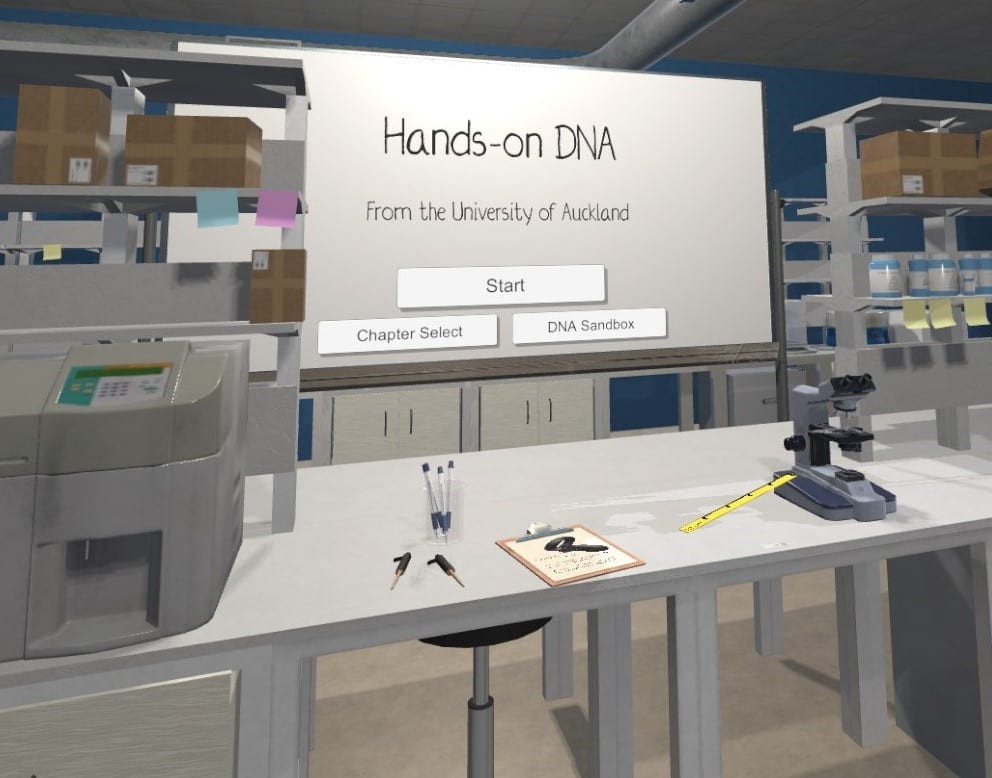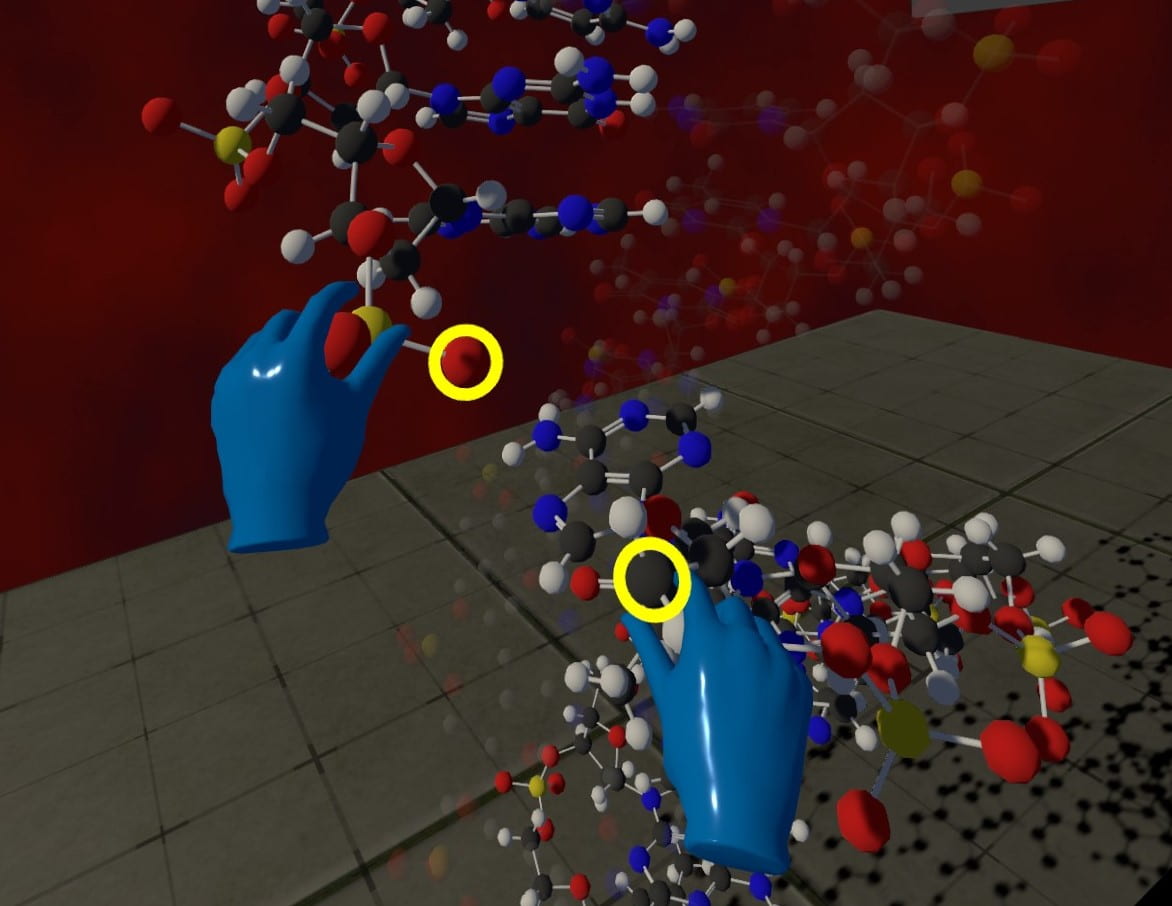
Hands-on dna: exploring the impact of virtual reality on teaching dna structure and function
Supervisor: A/Prof Jane Allison, School of Biological Sciences; Co-Supervisor: Dr Burkhard Wünsche, School of Computer Science, Sebastian Dunn, Masters in Bioinformatics; Research Assistants: Samuel Thompson and Dominik Lange-Nawka

Project outline
Hands-on DNA is a virtual reality (VR) learning experience developed for Sebastian’s MSc in Bioinformatics. The purpose of the project was to explore how the unique benefits of VR could be applied to issues encountered in tertiary molecular biology education. Molecular biologists study phenomena at sub-microscopic scales that cannot be experienced directly by human senses. VR has strong advantages in depictions of scale, and allows students to interact directly with molecules that they would otherwise have to learn about through 2D animations and images. The experience includes two scenes. Scene 1, the Lab, sees a student begin in a biology laboratory before shrinking in first person from normal to sub-microscopic size. Scene 2, the Cell, sees the student in a simple cell nucleus, interacting with accurate scale models of the DNA molecule as they complete a series of 5 learning activities. The intention is to give the student an intuitive sense of the scale of DNA, and then to develop their proportional reasoning skills while they discover the 3D structure of the molecule.
Impact of the Centre for eResearch
The Centre for eResearch (CeR) played multiple vital roles in the success of this project. Firstly, they provided the hardware we needed to build, test, and evaluate Hands-on DNA. Running a VR headset takes a relatively high level of computing power, and developing a VR experience in an editor like Unity takes this a magnitude further. Sebastian was working between the campus and home, making it difficult to continuously develop on a desktop PC. CeR loaned a VR-ready laptop for almost a year and a half, which allowed my development, thesis writing, and ran trials. The portability of the laptop also allowed Sebastian to take early builds of Hands-on DNA to outreach and networking events to showcase my research to many people during its development. This laptop had a major impact on my ability to continuously work and effectively expanded the scope that this project could achieve. CeR also provided us with an Oculus Quest-1 as a test device. As mentioned, building for multiple headsets was a priority for this project. Between the Allison Research group at SBS and the Graphics Group at SCS, we had access to a series of headsets, but were missing a Quest-1 to test with. It was vital to have access to a Quest-1 because it has higher processing constraints than tethered headsets and was the most likely headset to be used by educational institutions. By loaning us a Quest-1, CeR allowed us to test and build towards a major design goal and also allowed one of the developers to keep working during Covid-19 Alert Level 3/4 lockdowns when they otherwise would not have had the equipment.

See more case study projects

Our Voices: using innovative techniques to collect, analyse and amplify the lived experiences of young people in Aotearoa

Painting the brain: multiplexed tissue labelling of human brain tissue to facilitate discoveries in neuroanatomy

Detecting anomalous matches in professional sports: a novel approach using advanced anomaly detection techniques

Benefits of linking routine medical records to the GUiNZ longitudinal birth cohort: Childhood injury predictors

Using a virtual machine-based machine learning algorithm to obtain comprehensive behavioural information in an in vivo Alzheimer’s disease model

Mapping livability: the “15-minute city” concept for car-dependent districts in Auckland, New Zealand

Travelling Heads – Measuring Reproducibility and Repeatability of Magnetic Resonance Imaging in Dementia

Novel Subject-Specific Method of Visualising Group Differences from Multiple DTI Metrics without Averaging

Re-assess urban spaces under COVID-19 impact: sensing Auckland social ‘hotspots’ with mobile location data

Aotearoa New Zealand’s changing coastline – Resilience to Nature’s Challenges (National Science Challenge)

Proteins under a computational microscope: designing in-silico strategies to understand and develop molecular functionalities in Life Sciences and Engineering

Coastal image classification and nalysis based on convolutional neural betworks and pattern recognition

Determinants of translation efficiency in the evolutionarily-divergent protist Trichomonas vaginalis

Measuring impact of entrepreneurship activities on students’ mindset, capabilities and entrepreneurial intentions

Using Zebra Finch data and deep learning classification to identify individual bird calls from audio recordings

Automated measurement of intracranial cerebrospinal fluid volume and outcome after endovascular thrombectomy for ischemic stroke

Using simple models to explore complex dynamics: A case study of macomona liliana (wedge-shell) and nutrient variations

Fully coupled thermo-hydro-mechanical modelling of permeability enhancement by the finite element method

Modelling dual reflux pressure swing adsorption (DR-PSA) units for gas separation in natural gas processing

Molecular phylogenetics uses genetic data to reconstruct the evolutionary history of individuals, populations or species

Wandering around the molecular landscape: embracing virtual reality as a research showcasing outreach and teaching tool
























































































































































